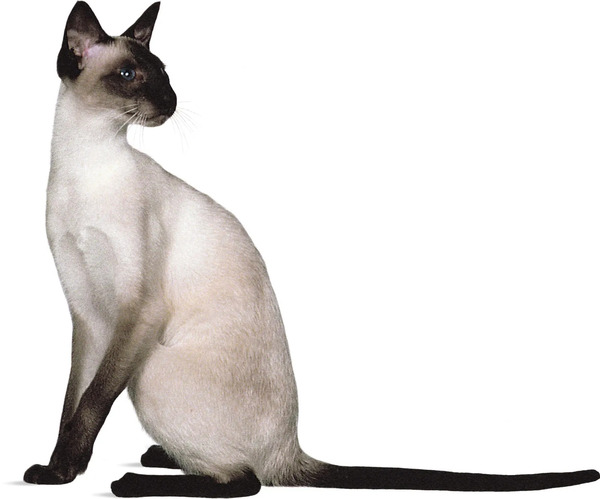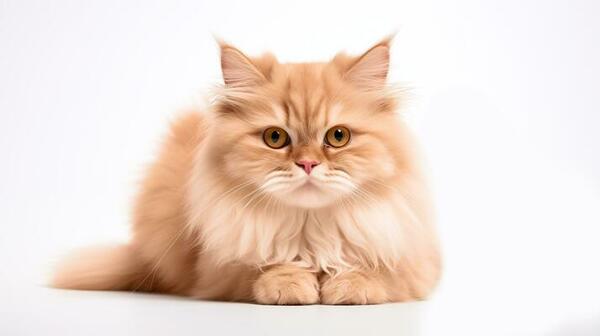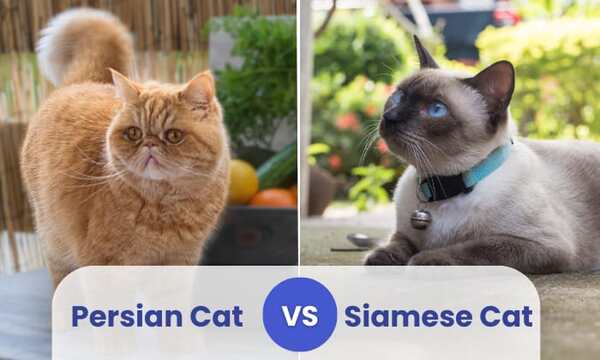When it comes to choosing a cat breed, Siamese and Persian cats are two of the most popular options. Both breeds have unique traits and personalities that appeal to different types of cat lovers. In this article, we will explore the key differences and similarities between Siamese and Persian cats to help you make an informed decision.

Siamese cats are known for their striking appearance and vocal personalities. They have a short, sleek coat and are often recognized for their distinctive color points on their ears, face, paws, and tail. Siamese cats are playful, social, and highly interactive, making them great companions.

Persian cats, on the other hand, are famous for their long, luxurious fur and flat faces. They tend to be more laid-back and enjoy a calm environment. Persians require regular grooming due to their thick coats but are known for their sweet, gentle demeanor.
Here’s a detailed comparison of the two breeds:
| Feature | Siamese Cat | Persian Cat |
|---|---|---|
| Appearance | Short, sleek coat; color points | Long, fluffy coat; flat face |
| Personality | Vocal, active, social | Calm, affectionate, reserved |
| Grooming Needs | Low grooming needs | High grooming needs (daily) |
| Lifespan | 12-20 years | 12-17 years |
| Exercise Needs | High (enjoys play and interaction) | Low to moderate (enjoys lounging) |
| Health Issues | Prone to respiratory issues | Prone to heart and kidney issues |
| Ideal Environment | Active households, families | Quiet homes, seniors |
Siamese cats have a sleek body with striking blue almond-shaped eyes and short, fine coats. Their unique color points—typically in shades of cream, chocolate, lilac, and blue—add to their beauty. In contrast, Persian cats have round faces and dense, flowing fur that requires regular grooming to prevent matting.
Siamese cats are known for their vocal and outgoing nature. They love to "talk" to their owners and can be quite demanding of attention. They thrive in social environments and often bond closely with their human companions. Persian cats are generally more reserved and enjoy a quieter lifestyle. They are affectionate but may not require as much interaction as Siamese.
Siamese cats are relatively low-maintenance in terms of grooming. Their short coats only need occasional brushing. Persian cats, however, need daily grooming to keep their long fur healthy and free of tangles. Regular grooming also helps to reduce shedding and hairballs.
Both breeds have similar lifespans, with Siamese cats living between 12 to 20 years and Persian cats living around 12 to 17 years. However, individual health and care can significantly affect their longevity.
Siamese cats are energetic and require regular playtime to keep them stimulated. They enjoy interactive toys and games with their owners. Persian cats, while playful, tend to be more sedentary and are content with short bursts of play followed by relaxation.
Siamese cats may be prone to certain respiratory issues due to their narrow heads and noses. Persian cats are more susceptible to genetic health problems such as heart disease (hypertrophic cardiomyopathy) and kidney disease due to their breeding.
Siamese cats thrive in active households with plenty of interaction and stimulation. They are great companions for families with children and other pets. Persian cats, on the other hand, are better suited for quieter homes where they can relax and enjoy their surroundings, making them a good choice for seniors or individuals seeking a more laid-back pet.

When considering whether Persian and Siamese cats can live together harmoniously, it’s important to understand their distinct personalities and temperaments. Both breeds have unique traits that can affect their interactions, so let’s explore how these two breeds can coexist.
Siamese Cats:
Social and Vocal: Siamese cats are known for being very social and vocal. They thrive on interaction with their human companions and often seek out attention. They can be quite assertive and may demand playtime or cuddles.
Playful and Active: They are energetic and enjoy engaging in play, which can include chasing toys and climbing.
Persian Cats:
Calm and Affectionate: Persian cats are typically more laid-back and prefer a calm environment. They are affectionate but not as demanding of attention as Siamese cats.
Less Active: They tend to enjoy lounging and relaxing rather than engaging in vigorous play.
Temperament Differences:
The outgoing and playful nature of Siamese cats may sometimes clash with the more relaxed and gentle demeanor of Persians. Siamese cats may overwhelm a Persian with their energy and need for interaction.
Socialization:
If properly socialized from a young age, both breeds can learn to coexist peacefully. Early introductions and positive reinforcement can help them develop a friendly relationship.
Space and Environment:
Providing separate spaces for each cat can be beneficial. Siamese cats may require more play space, while Persians might prefer cozy, quiet areas to relax. Ensuring both breeds have their own territory can reduce stress and potential conflicts.
Supervised Introductions:
When introducing a Siamese and a Persian cat, it’s best to do so gradually and under supervision. Allow them to sniff each other through a door or gate before direct interactions. Positive reinforcement, like treats and praise, can encourage good behavior during introductions.
Understanding Each Other's Cues:
Cats communicate through body language. Teaching both cats to recognize and respect each other’s cues can help minimize misunderstandings. For example, if one cat shows signs of discomfort, it’s important to give them space.
Play Style Differences:
The active play style of a Siamese may be too intense for a Persian, who may not enjoy rough play. If playtime becomes too boisterous, the Persian may retreat, leading to a lack of interaction.
Vocalization:
Siamese cats are quite vocal and may try to engage the more reserved Persian. This can be overwhelming for the Persian, who may prefer a quieter environment.
Health Considerations:
If either cat has health issues or is elderly, it’s essential to monitor their interactions closely. A senior Persian, for example, may not be able to keep up with a playful Siamese.
In summary, while Persian and Siamese cats have different personalities, they can get along if introduced properly and given the right environment. Understanding their individual needs and characteristics is key to fostering a peaceful relationship. With patience, socialization, and positive reinforcement, it’s entirely possible for a Persian and Siamese cat to coexist happily in the same household.
When deciding between a Persian kitten and a Siamese cat, it’s important to consider various factors, including personality, grooming needs, health, and your lifestyle. Each breed has its unique characteristics and requirements, so understanding these can help you make the best choice for your home. Here’s a detailed guide to help you decide.
Siamese Kittens:
Social and Vocal: Siamese cats are known for their outgoing nature and vocalization. They enjoy interacting with people and are often very affectionate. If you want a cat that will engage with you and be a part of your daily activities, a Siamese might be the right choice.
Playful and Energetic: Siamese kittens are typically very playful and require more stimulation. They enjoy playing games and exploring their environment, which makes them active companions.
Persian Kittens:
Calm and Affectionate: Persians are generally more laid-back and may prefer a quieter environment. They are affectionate but often enjoy a more relaxed interaction with their owners.
Less Active: Persian kittens may not require as much playtime as Siamese, making them suitable for those who prefer a more serene companion.
Siamese Kittens:
Low Maintenance: Siamese cats have short, sleek coats that require minimal grooming. Regular brushing is helpful, but they generally don’t mat or tangle easily.
Persian Kittens:
High Maintenance: Persians have long, luxurious fur that requires regular grooming to prevent matting. Daily brushing is recommended, and you may need to schedule professional grooming sessions to keep their coats in top condition.
Siamese Cats:
Common Health Issues: Siamese cats can be prone to certain health issues, including respiratory problems and dental issues. Regular vet check-ups are essential to monitor their health.
Persian Cats:
Brachycephalic Concerns: Persians are brachycephalic (flat-faced), which can lead to breathing difficulties. They may also have specific genetic health concerns, such as polycystic kidney disease (PKD). Ensuring you get your Persian from a responsible breeder can help minimize health risks.
Activity Level:
Consider your activity level and how much time you can dedicate to play and interaction. If you lead a busy lifestyle and prefer a more independent cat, a Persian might suit you better. However, if you have the time to engage in play and social interaction, a Siamese could be a wonderful choice.
Space:
Siamese cats typically enjoy more space to explore and play, while Persians may be more content in a quieter environment. Consider your living situation and how much space you can provide.
Siamese Kittens:
They are usually more adaptable and may get along well with other pets due to their social nature. If you have other active pets, a Siamese may fit in well.
Persian Kittens:
They tend to be more reserved and may require a gentler introduction to other pets. If you already have pets, consider their personalities and how they may interact with a new cat.
Choosing between a Persian kitten and a Siamese cat depends on your preferences, lifestyle, and the type of companionship you seek. If you desire an active, social, and vocal pet, a Siamese might be the perfect fit. Conversely, if you prefer a calm, affectionate companion that requires less activity and interaction, a Persian could be ideal.
Ultimately, spend time with both breeds before making a decision. Visiting breeders or rescue organizations can help you understand each breed's unique qualities and find the right cat for your home. Regardless of your choice, both Persian and Siamese cats can make wonderful additions to your family.
When choosing a pet cat, price is an important factor to consider. Siamese and Persian cats are two popular breeds, and their prices can vary due to several factors. Below, we will explore the price differences between these two breeds in detail.
Price Range:
The price of Siamese cats typically ranges from $500 to $2,000, depending on factors such as lineage, breeder reputation, location, and the cat's appearance.
Influencing Factors:
Lineage: Purebred Siamese cats tend to be more expensive, especially those with champion bloodlines.
Age: Kittens usually cost more than adult cats because they are more sought after.
Breeder: Choosing a reputable breeder can increase the price, as they often provide health guarantees and maintain good breeding practices.
Price Range:
The price of Persian cats generally falls between $500 and $5,000, with some high-quality Persians potentially costing even more, especially those with unique colors or lineage.
Influencing Factors:
Lineage and Appearance: High-quality Persian cats, particularly those with beautiful coats and unique colors, tend to be more expensive.
Breeder: Similar to Siamese cats, Persians from reputable breeders often come at a higher price due to health assurances and proper socialization.
In addition to the purchase price, there are other related expenses to consider:
Medical Expenses:
Regular veterinary check-ups, vaccinations, spaying/neutering, and treatment for potential health issues are necessary costs associated with cat ownership.
Food and Supplies:
Daily expenses for cat food, litter, toys, and scratching posts will also add to the overall cost.
Grooming Costs:
Persian cats' long fur requires regular grooming, which may necessitate professional grooming services, adding to the expense.
Overall, Persian cats are generally more expensive than Siamese cats, particularly high-quality Persians. However, the price difference is influenced by various factors, including lineage, breeder, and location. When selecting a pet cat, it’s essential to factor in not just the initial purchase cost but also long-term care and daily expenses. Regardless of the breed chosen, ensuring the cat comes from a responsible breeder is crucial for its health and well-being.

A mix between a Persian cat and a Siamese cat is often referred to as a "Siamese-Persian mix" or a "Siamese-Persian hybrid." These mixed-breed cats combine the distinct characteristics of both parent breeds, resulting in a unique and charming feline companion.
Appearance:
Coat: The coat of a Siamese-Persian mix can vary widely. Some may inherit the long, luxurious fur of the Persian, while others might have a shorter, sleek coat typical of Siamese cats. The mix can also result in a combination of both fur types.
Color: These cats may have color points like Siamese, with darker hues on the ears, face, paws, and tail, along with the solid or tabby patterns often seen in Persians.
Personality:
Social Nature: Siamese cats are known for their outgoing and vocal personalities, while Persians tend to be more laid-back and affectionate. A mix of these two breeds can result in a cat that is both playful and cuddly, often enjoying social interaction but also appreciating quiet moments.
Intelligence: Both breeds are intelligent, so a Siamese-Persian mix may exhibit cleverness and curiosity, making them engaging companions.
Grooming Needs:
Grooming: The grooming needs will depend on the coat type inherited. If the cat has a long coat, regular brushing will be necessary to prevent matting and tangles, similar to a Persian. If the coat is shorter, grooming may be less intensive.
Health Considerations:
Potential Health Issues: Mixed-breed cats generally benefit from hybrid vigor, potentially reducing the likelihood of some hereditary health problems. However, they may still inherit health issues from either breed, such as respiratory problems from the Siamese side or heart issues from the Persian side. Regular veterinary check-ups are essential for monitoring health.
Diet: A balanced diet is crucial for maintaining a healthy weight and overall well-being. Consult your veterinarian for recommendations based on the cat's age, size, and activity level.
Exercise: Regular playtime is important for keeping your cat mentally and physically stimulated. Interactive toys and scheduled play sessions can help keep them active.
Socialization: Encourage social interaction by spending time with your cat and introducing them to new environments. This will help them develop a well-rounded personality.
Routine Veterinary Care: Ensure your cat receives routine check-ups, vaccinations, and dental care to keep them healthy throughout their life.
A Siamese-Persian mix is a delightful combination of two beloved breeds, bringing together the best of both worlds. With their unique looks, engaging personalities, and affectionate nature, these mixed-breed cats can make wonderful companions for various households. Whether you're drawn to their beauty or charm, a Siamese-Persian mix can be a perfect addition to your family.
Choosing between a Siamese cat and a Persian cat ultimately depends on your lifestyle and preferences. If you’re looking for an active, vocal companion, a Siamese might be the right fit. However, if you prefer a calm, affectionate cat that enjoys lounging, a Persian could be the perfect choice. Understanding the differences between these two beloved breeds can help you find the ideal furry friend for your home.
animal tags: Siamese-cat Persian-cat
We created this article in conjunction with AI technology, then made sure it was fact-checked and edited by a Animals Top editor.